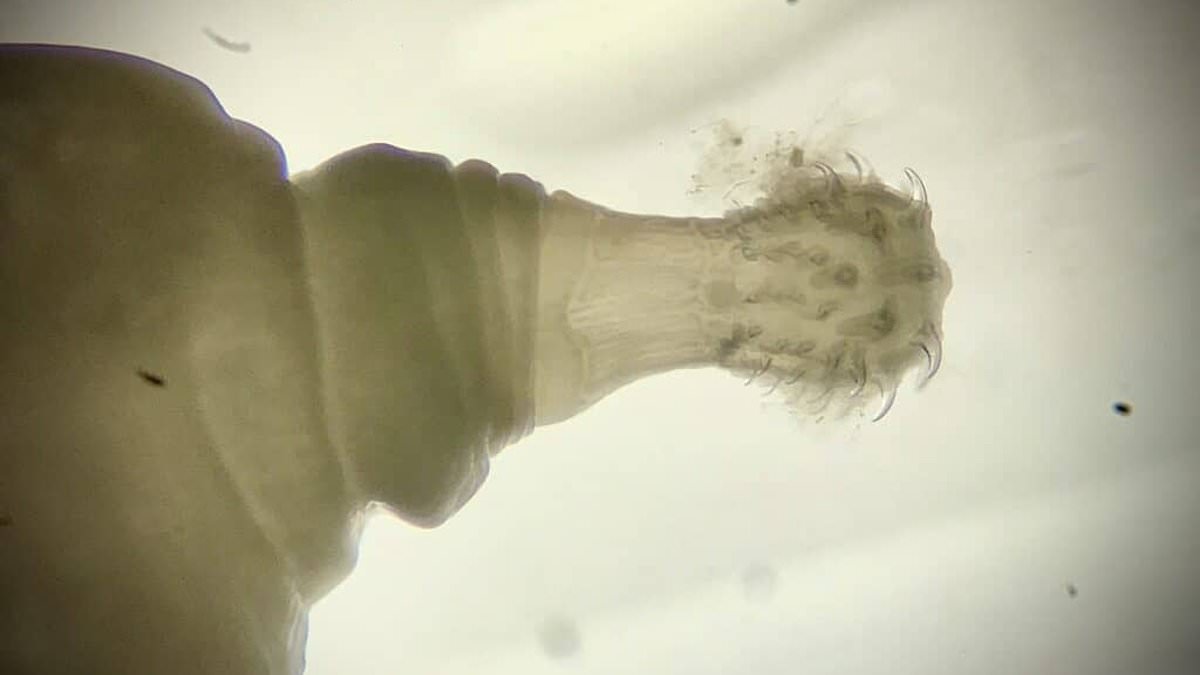A recently discovered ‘hook-headed’ parasite is brutally killing off a nearly endangered species on a picturesque island off the coast of California.
The Pachysentis canicola parasite was first discovered on Santa Barbara County’s San Miguel Island after researchers found native animals dead or severely emaciated in 2012.
The deadly parasite lives inside its host’s intestines, eroding and inflaming the host’s insides until its removal or the animal’s death.
The nightmare creature now threatens a fleeting population of native island foxes, which were only recently delisted from the US Endangered Species Act in 2016.
With the help of researchers, the San Miguel Island fox made a slow but successful recovery following a steep population decline in the early 2000s.
Despite the US Fish and Wildlife Service removing predators and other invasive species from the 9,325-acre island, researchers have again noted a steep decline in the fox population.
And there are clear, disturbing signs of what is to blame.
A large number of foxes that scientists necropsied or monitored after Pachysentis canicola’s discovery carried the parasite and displayed poor body condition and low weight.
Such discoveries have ‘raised alarms about this new parasite,’ Oscar Alejandro Aleuy, a biology professor at Florida Atlantic University, told The Wildlife Society.
Researchers also attribute the decline to a ‘severe drought’ that may have exacerbated the damage caused by the parasites.
‘It’s like the perfect storm,’ Alejandro Aleuy said. ‘You have an island full of foxes, a severe drought and this new pathogenic parasite showing up. That might have caused the foxes to decline dramatically.’
‘It’s very hard to disentangle the environment and the parasite from the population of foxes. These are all underlying mechanisms that we need to research more in detail.’
Aleuy suspects that researchers may have accidentally imported infected animals during the foxes’ captive breeding program.
However, a small possibility exists that the harmful parasite had always been on the island but remained undetected until recently.
‘We can’t be 100 percent certain it’s invasive, but it’s very likely,’ Alejandro Aleuy said.
So far, Pachysentis canicola has only been found on San Miguel Island and has yet to ‘jump’ to any of the fox’s subspecies on the other Channel Islands – including the Santa Catalina Island fox which remains listed on the US Endangered Species Act.
Researchers, including Alejandro Aleuy, believe there are intermediate parasite hosts, but they have not yet identified what that species may be.
‘Such knowledge will be important for understanding how the parasite completes its life cycle on the islands,’ he said.
Alejandro Aleuy also claimed that the native fox species may have previously reached its ‘carrying capacity’ on the island, which may have aided in its population decline.
‘The problem is that we don’t really know the carrying capacity of the island,’ he said.
Researchers plan to continue monitoring and further researching the life cycle of the nearly endangered animals, hopefully helping wildlife managers to figure out what is going on with more certainty.
The shocking discovery comes just days after a fly that lays flesh-eating larvae was detected in Mexico and could threaten humans and wildlife in Texas.
The Texas Department of Parks and Wildlife has since issued an urgent warning to its Southern residents to keep an eye out for the New World Screwworm, whose Latin name, hominivorax, means ‘man-eater.’
On November 22, a cow was found with the larvae at an inspection checkpoint in Chiapas, near the Mexico-Guatemala border.
‘As a protective measure, animal health officials ask those along the southern Texas border to monitor wildlife, livestock and pets for clinical signs of [the insect] and immediately report potential cases,’ the TPWD said in a statement.
The screwworm has been ‘progressively’ migrating northward, according to the agency, and it primarily infects livestock.
It can, however, affect humans and wildlife, including deer and birds, TPWD said.
The parasite hasn’t been seen in the US since 1966 after extensive federal and state sterilization process managed to eradicate the fly from the States.
Experts are worried it could have a devastating effect on the US economy if it were to reach the US.
‘It can have a huge impact, certainly an economic impact, because it decreases the health and wellness of our livestock,’ Texas Tech School of Veterinary Medicine Associate Professor Jennifer Koziol told Drovers.
‘We’re thinking about loss of animal use, and certainly thinking about our wildlife populations that could be decimated by this disease.’
The screwworm begins its reign of terror when the female fly lays her eggs into an open wound or orifices.
The female flies are drawn to the open wounds and orifices by the odors they emit. They can be as small as a tick bite, a nasal or eye opening, a navel of a newborn or genitalia, the TPWD said.
These eggs then hatch into dangerous larvae that burrow into the wound like screws, according to the agency.
Female flies can lay up to 200 to 300 eggs at once and up to 3,000 in her lifetime, according to KHOU 11. Infestations can also be visible on the skin.
Infections can be deadly and are often serious. The New York Times reported in 1977 that one infection could ‘kill a fully grown steer in 10 days.’
The government organization recommends covering all open wounds, especially if traveling in affected areas, such as Central or South America. It also recommended wearing insect repellant while hunting, hiking or bird watching.
